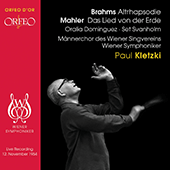Set Svanholm
Svanholm’s father, a Lutheran priest, taught him to play the organ. Gradually he gained experience as a church choirmaster and conductor and taught in a local school for two years. In order to amass the financial means for further musical study he gave organ recitals, and in 1927 entered the Royal Stockholm Conservatory where he studied counterpoint, composition and piano, graduating in 1929. Svanholm next became choirmaster at St James’s Church, Stockholm, an appointment he retained for the next twenty years, while also studying singing (as a baritone) with John Forsell, himself a noted singer and director of the Royal Swedish Opera from 1923 to 1939.
It was as Silvio / Pagliacci, with the Royal Swedish Opera, that Svanholm made his operatic debut in 1930; followed by Figaro / Il barbiere di Siviglia, singing opposite Jussi Björling as Count Almaviva. Since however Svanholm’s wife Nine Högstedt was insistent that he was really a tenor, after several years as a baritone he retired in order to retrain as a tenor and made his debut as such in the autumn of 1936, once again with the Royal Swedish Opera, as Radamès / Aida. He quickly moved on to other parts, in 1937 singing the title role in Lohengrin and Siegmund / Die Walküre, as well as Lemminkäinen in the first performance of The Princess of Cyprus by Lars-Erik Larsson. His Stockholm repertoire went on to include Manrico / Il trovatore, Canio / Pagliacci, Florestan / Fidelio, Bacchus / Ariadne auf Naxos, Tristan / Tristan und Isolde, the tenor roles of Der Ring des Nibelungen and the title parts in Idomeneo and Otello. In addition he sang Erland in the first performance in 1940 of Gunnar de Frunerie’s opera Singoalla and in 1946 was the first Peter Grimes to be heard outside England.
Svanholm’s international career took off quickly: Bruno Walter had heard him in Stockholm and during 1938 he made his debut as Siegmund with the Vienna State Opera, to which he would return many times, as well as in Munich, Graz, Prague and Budapest, where he was obliged to encore ‘Di quella pira’ (Il trovatore) three times. He also attracted much attention at the 1938 Salzburg Festival where he sang Walther / Die Meistersinger von Nürnberg and the title role in Tannhäuser. During 1942 he made his debut at La Scala, Milan as Tannhäuser and appeared at the Bayreuth Festival as Erik / Der fliegende Holländer and as Siegfried / Der Ring des Nibelungen.
In 1940 Svanholm had been approached to sing with the Metropolitan Opera, New York but was prevented by the course of World War II. Eventually, after singing with the companies of San Francisco and Chicago during September and October 1946, he finally arrived at the Met, making his debut as Siegfried in November of that year. A key member of the German wing at the Met up until 1956, he sang Tristan, Siegmund, Siegfried, Walther, Lohengrin, Tannhäuser, Erik, Loge / the Ring, the title role in Parsifal and Florestan; as well as Radamès and Otello, character parts such as Herod / Salome, Aegisth / Elektra, Eisenstein / Die Fledermaus and a single Admète / Alceste.
Early in the 1948–1949 season of the young Covent Garden Opera Company Svanholm made his debut in London (as Siegfried), He returned frequently until 1955, predominantly as Loge, Siegmund and Siegfried as well as Lohengrin, Walther and Tristan.
Like his voice teacher Forsell, Svanholm became director of the Royal Swedish Opera, serving as such between 1957 and 1962. He did however continue to sing, notably as Loge in the Solti / Culshaw recording of Das Rheingold made in 1958; and as late as 1960 undertook Rienzi in a concert performance of this opera in Vienna conducted by Josef Krips.
As a singer Svanholm possessed extraordinary stamina, which explains both his success and longevity in the Wagnerian repertoire. His voice could seem at times rather dry compared with that of Melchior, but he was an exemplary musician and looked good on stage, with a tall and youthful presence, and was Kirsten Flagstad’s preferred tenor partner. Although he made few commercial recordings, many live performances have achieved considerable circulation.
© Naxos Rights International Ltd. — David Patmore (A–Z of Singers, Naxos 8.558097-100).

















